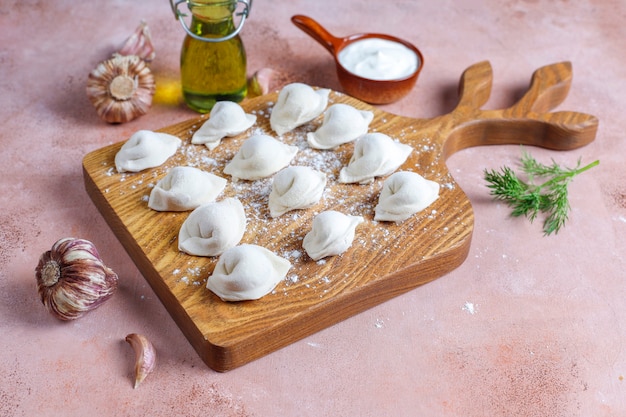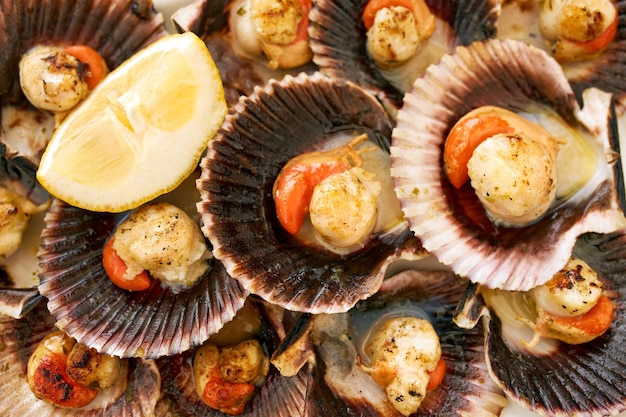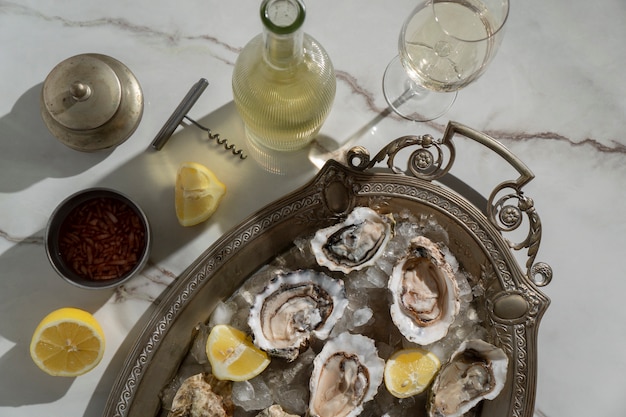There's a certain thrill that comes with seeing a glistening pile of scallops at the fishmonger. They're undeniably elegant, beckoning you with their pearly sheen and promise of deliciousness. But then reality sets in: "Scallops? I've always wanted to try cooking them, but what if I mess it up?"
Let me tell you, that fear is completely unfounded. Scallops are actually quite forgiving, and with the right approach, they can be a culinary triumph. It's all about understanding their quirks and knowing a few tricks of the trade.
This guide is your roadmap to scallop perfection. It's packed with tips and tricks I've gleaned over years of experimentation (and a few kitchen mishaps along the way). So grab a glass of your favorite beverage, get comfy, and let's dive into the wonderful world of scallops.
(Part 1) Choosing the Right Scallops

The first step on this delicious journey is selecting the perfect scallops. Don't just grab the first bag you see! There are a few key factors to consider.
Types of Scallops: A Matter of Taste
There are two main categories of scallops: bay scallops and sea scallops. They each have their own distinct character:
- Bay scallops are the smaller, more delicate cousins. They have a sweet, slightly buttery flavour and are often described as "melt-in-your-mouth." They're typically found in the Gulf of Mexico and the Atlantic Ocean, and their scarcity makes them a bit pricier.
- Sea scallops are larger, with a more robust, briny flavour. They have a firmer texture, and their abundance makes them more budget-friendly. They're commonly found in the North Atlantic Ocean.
The choice ultimately comes down to personal preference. For a refined, nuanced flavour, Bay scallops are the winner. But if you're after a heartier, more substantial experience, Sea scallops will satisfy. It's like choosing between a delicate white wine and a full-bodied red - both have their merits.
Freshness Is King
Freshness is the most crucial factor in ensuring delicious scallops. Here's how to spot the good ones:
- A pearly gleam: fresh scallops have a shiny, iridescent surface that catches the light. Look for those pearly tones.
- The scent of the sea: They should smell fresh and briny, not fishy or stale. If there's any off-putting aroma, steer clear.
- Firmness and spring: The muscle should be firm to the touch and spring back when pressed. Avoid any scallops that are mushy or slimy, as those are signs of spoilage.
And a little tip from a seasoned scallop enthusiast: If you're buying pre-shucked scallops, always ask for them on ice. They're sensitive souls and can lose their plumpness quickly if left out in the open.
(Part 2) Preparing Your Scallops for Cooking

Now that you've got your precious scallops, let's get them ready for the star treatment. This stage might seem simple, but there are a few subtle steps that can make a big difference in the final result.
Patting Dry: The Secret to a Crispy Crust
First things first: those scallops need a good patting dry. It might sound insignificant, but trust me, it's a crucial step. Scallops are naturally moist, and all that excess water will create steam during cooking. Steam is the enemy of a crispy crust! It'll leave your scallops limp and soggy, which is a culinary tragedy no one wants to witness.
So, grab some kitchen paper and gently pat those scallops dry, getting rid of any lingering moisture. This will help ensure a delicious, golden-brown crust forms, sealing in the succulent flavour inside.
Seasoning Wisely: Less is More
Now for seasoning. Remember, scallops are delicate, so a light touch is key. Too much salt can overpower their natural sweetness and leave them tasting bland. A light dusting of salt and pepper is usually all they need.
Want to add a touch of sophistication? I like to sprinkle a pinch of paprika or cayenne pepper. Just a hint of spice elevates the dish, adding complexity and a subtle kick.
The Adductor Muscle: To Remove or Not to Remove?
This is where opinions diverge. The adductor muscle is the white, chewy part in the centre of the scallop. Some people swear by removing it, claiming it makes the scallop more tender. Others argue it adds texture and contributes to the flavour.
My stance? It's entirely up to you! If you're after a silky-smooth, melt-in-your-mouth experience, then removing the adductor muscle might be worth it. But if you enjoy a bit of chew and prefer a more robust flavour, leave it in. Experiment and see what tickles your palate.
(Part 3) cooking scallops: Exploring the Methods

Now for the fun part: choosing your cooking method. There are several techniques that can transform those scallops into a culinary masterpiece. Let's explore them!
Searing: The Classic and Iconic Method
Searing is the most common way to cook scallops, and for good reason. It produces a beautiful, caramelized crust while keeping the inside perfectly tender and juicy. You'll want a good quality pan, preferably cast iron or stainless steel, as these retain heat exceptionally well.
Here's the basic searing technique:
- Heat your pan: Get your pan scorching hot over medium-high heat. You want it sizzling when the oil is added.
- Oil it up: Add a small amount of oil, like olive oil or grapeseed oil, to the hot pan. It should shimmer and move freely.
- Add the scallops: Carefully place your scallops in the pan, making sure not to overcrowd it. Give them space to cook evenly and develop a beautiful crust.
- Time it right: Cook for about 2-3 minutes per side, or until golden brown and cooked through.
You'll know they're done when the inside is no longer translucent but opaque, and the edges are slightly caramelized.
Pan-frying: A Gentler Approach to a Crispy Crust
If you prefer a slightly more delicate flavour, pan-frying is a great alternative. It's very similar to searing, but with a gentler approach.
Simply follow the same steps as above, but reduce the heat to medium. This will result in a beautifully browned scallop with a slightly more tender inside.
Grilling: Adding a Smoky Dimension
Grilling scallops adds a smoky depth to their flavour. It's perfect for outdoor entertaining, especially during the warmer months.
- Preheat your grill: Set your grill to medium-high heat. Clean the grates and oil them lightly to prevent sticking.
- Grill time: Place the scallops directly on the grill. They'll develop a lovely grill mark and absorb the smoky aroma.
- Cook evenly: Grill for about 2-3 minutes per side, or until cooked through.
Be mindful of flare-ups! And remember, scallops cook quickly, so don't overcook them.
Baking: A No-Fuss Method for a Simple Yet Delicious Dish
Baking scallops might seem unconventional, but it's a fantastic option for a no-fuss, fuss-free approach. It's perfect if you're looking for a simple yet delicious way to cook them.
- Preheat the oven: Set your oven to 400 degrees F (200 degrees C).
- Prepare the baking sheet: Line a baking sheet with parchment paper for easy cleanup.
- Bake away: Place the scallops on the baking sheet and bake for 8-10 minutes, or until cooked through.
This method might not yield the same crispy exterior as searing or pan-frying, but it will still deliver tender and flavorful scallops.
(Part 4) The Perils of Overcooked Scallops: A Culinary Crime
Remember, scallops are fast cooks! Overcooking them is a culinary crime that will result in a tough, rubbery mess, devoid of their delightful flavour.
Here's how to avoid this scallop tragedy:
- The opacity test: The inside of the scallop should be opaque, not translucent. This indicates it's cooked through.
- Caramelized edges: The edges should be slightly caramelized, but not burnt. This signifies a nice sear without going overboard.
- Firmness: The scallop should be firm to the touch, but not hard. This means it's cooked, but still tender.
A good rule of thumb is to cook them for about 2-3 minutes per side. If you're unsure, err on the side of undercooking. You can always cook them a bit longer if needed.
(Part 5) Serving Scallops: Beyond the Ordinary
Now that you've mastered the art of cooking scallops, it's time to think about what to pair them with. The culinary world is your oyster (or scallop, in this case), so get creative! Here are a few ideas to get your taste buds tingling.
Classic Combinations: Tried and True
- Lemon butter sauce: A timeless classic that never disappoints. The tangy lemon and rich butter create a symphony of flavour that complements the delicate sweetness of scallops perfectly.
- Garlic and herbs: Simple yet incredibly effective. Garlic and fresh herbs like parsley, thyme, or rosemary add a delicious depth of flavour and aroma that elevate the dish.
- Cream sauce: A decadent and luxurious choice. A creamy sauce with a touch of white wine or lemon juice creates a luxurious sauce that pairs beautifully with scallops.
More Adventurous Options: Stepping Outside the Box
- Spicy chorizo: For a fiery twist, try pairing scallops with spicy chorizo sausage. The sweet and spicy interplay is a taste sensation that will tantalize your senses.
- Asian-inspired flavours: Scallops pair beautifully with the vibrant flavours of ginger, soy sauce, and sesame oil. Explore the world of stir-fries or create a delicate Asian-inspired sauce.
- Mango salsa: A vibrant and refreshing mango salsa adds a touch of sweetness and acidity that complements the rich flavour of scallops. It's a delightful contrast of textures and tastes.
Serving Suggestions: Variety is the Spice of Life
Scallops are incredibly versatile and can be enjoyed in a variety of ways. They make a stunning appetizer, a delightful main course, or even a unique addition to salads.
- Appetizer: Serve scallops on skewers with a dipping sauce. It's a sophisticated and elegant way to start a meal.
- Main course: Pair scallops with pasta, risotto, or couscous for a flavourful and satisfying meal.
- Salad: Toss scallops with mixed greens, cherry tomatoes, and a light vinaigrette for a refreshing and light meal.
(Part 6) storing scallops: Keeping Those Precious Pearls Fresh
You've bought your scallops, cooked them to perfection, but you haven't finished them all. Don't worry, they can be stored safely for later enjoyment. Here's how:
Fresh Scallops
- Refrigerator: Store fresh scallops in the refrigerator for up to 2 days. Place them in a sealed container and submerge them in cold water. This keeps them moist and prevents them from drying out.
- Freezing: You can freeze fresh scallops for up to 3 months. Spread them in a single layer on a baking sheet and freeze until solid. Then transfer them to a freezer-safe bag or container.
Cooked Scallops
- Refrigerator: Refrigerate cooked scallops in an airtight container for up to 3 days.
- Freezing: You can freeze cooked scallops for up to 2 months.
Always remember to thaw scallops in the refrigerator before cooking or reheating. This ensures they thaw evenly and retain their moisture.
(Part 7) Scallop FAQs: Getting the Inside Scoop
You've read through all the tips and tricks, but you still have some questions? It's perfectly normal! Here are some answers to common scallop inquiries:
1. Can I eat the shell of a scallop?
No, you should not eat the shell of a scallop. The shell is made of calcium carbonate, which is not digestible. It's meant to protect the scallop, not be consumed.
2. What are those little black things in the scallop?
Those are the scallop's guts or roe. They are edible, but some people find them bitter. You can remove them if you prefer a cleaner, more subtle flavour.
3. Why are scallops so expensive?
Scallops are expensive because they're a relatively rare and delicate seafood. They're also labor-intensive to harvest, which adds to their cost. Their unique flavour and tender texture make them worth the splurge!
4. Can you eat raw scallops?
Yes, you can eat raw scallops. They're often served as sashimi or ceviche. However, it's crucial to use fresh, high-quality scallops and ensure they're properly cleaned and chilled.
5. How do you tell if a scallop is bad?
Bad scallops will have a slimy texture, a fishy smell, and may be discolored. If you see any of these signs, it's best to discard them. Fresh scallops should have a firm texture, a pleasant briny smell, and a pearly white or light tan color.
(Part 8) Embracing the Joy of Scallops
Cooking scallops can seem daunting at first. But with a little practice and the knowledge you've gained, it becomes a truly rewarding experience. You'll be amazed at how easy it is to achieve delicious results, and you'll soon be wowing your friends and family with your newfound culinary skills.
So, next time you're at the fishmonger, don't be shy! Take a chance on those pearly beauties. You'll be glad you did.
Everyone is watching

Perfect Rice Every Time: The Ultimate Guide to Cooking Rice
Cooking TipsAs a self-proclaimed foodie, I've always been a bit obsessed with rice. It's the foundation of countless cuisi...

Prime Rib Roast Cooking Time Chart: Per Pound Guide
Cooking TipsPrime rib roast. Just the name conjures images of lavish dinners, crackling fires, and hearty laughter. It’s ...

The Ultimate Guide to Cooking Asparagus: Tips, Techniques, and Recipes
Cooking TipsAsparagus. The mere mention of this spring delicacy conjures up images of vibrant green spears, crisp and burs...

Ultimate Guide to Cooking the Perfect Thanksgiving Turkey
Cooking TipsThanksgiving. Just the word conjures up images of overflowing tables laden with delicious food, the scent of r...

How Long to Bake Potatoes in the Oven (Perfect Every Time)
Cooking TipsBaked potatoes are a staple in my kitchen. They're incredibly versatile, delicious, and surprisingly easy to m...
